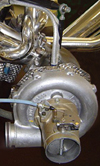Scavenging the turbo
 In any dry-sump engine application the task of getting the oil out of the sump is often much harder than putting it in. This is because oil tends to flow better at the 3-4 bar pressure at the outlet of a pump than it does at the 0-0.7 bar depression of the oil-air mixture at the inlet. For this reason you will often see at least two scavenge stages emanating from the sump of a dry-sump engine and possibly another from each of any cylinder heads.
In any dry-sump engine application the task of getting the oil out of the sump is often much harder than putting it in. This is because oil tends to flow better at the 3-4 bar pressure at the outlet of a pump than it does at the 0-0.7 bar depression of the oil-air mixture at the inlet. For this reason you will often see at least two scavenge stages emanating from the sump of a dry-sump engine and possibly another from each of any cylinder heads.
For a vee engine, therefore, we are likely to see at least four scavenge stages to the oil pump. The problems, however, start to multiply when this installation includes one, possibly even two exhaust gas-driven turbochargers.
Unlike mechanical, crankshaft-driven superchargers, turbochargers need a high-pressure oil feed not only to lubricate the fully floating bearings but to cool them as well. Engine oil at engine main gallery pressure is consequently taken from a convenient tapping point and directed into the top of the turbo bearing housing.
Here, when the turbo is running at high speed and the fully floating bearing system is working as it should, the oil is chopped up and mixed with the air and any exhaust gas leakage to form a dirty whitish-brown mixture that can have the texture of whipped cream at times. This falls down the much larger oil drain and discharges into the sump above the level of any oil in it. And so long as the turbo unit is mounted high enough for this mixture to drain into the top of the crankcase - which is what turbo manufacturers specify - everything else being equal, all should be OK.
A problem arises, however, when the engine packaging boys get their way and the delicate balance of pressures inside the turbocharger bearing housing become disturbed, with potentially catastrophic results. Insisting on low-mounted turbo units, one either side and hidden snugly from view in the car sidepod, this can present major problems to the engine designer.
You see, oil simply does not flow uphill. And when the turbo bearing housing is lower than the engine sump, the tendency would be for the oil to flow from the sump into the bearing housing, rather not the other way around as nature intends. Creating a depression in the sump might help, but the tendency for the oil to drain back towards the turbo will always prevail.
If I had my way, this would be the first thing I would change. If liquids could flow uphill naturally, without any coercion, I am sure many common engineering problems could be solved overnight! It might create some more but we wouldn't need to provide additional scavenge underneath each turbo to direct the oil mixture back to the oil tank. We probably also wouldn't need a small-volume/catch tank underneath the turbo bearing housing to collect the oil and allow enough time for at least some of the air to diffuse out.
If oil could flow uphill we wouldn't therefore need a balance pipe to vent this air away from the bearing housing to a catch tank or the engine breather system, and life would be much simpler. At the same time though, it wouldn't be quite so much fun for us engineers!
So the next time you see turbochargers mounted low down in the engine sidepod, just think about the poor engineer who had to reverse the laws of nature to get the oil to drain uphill.
Fig. 1 - Sidepod-mounted turbocharger installation
Written by John Coxon